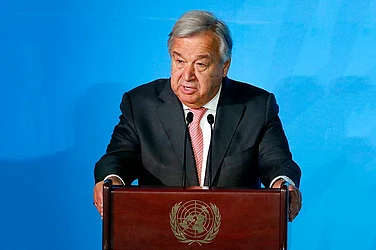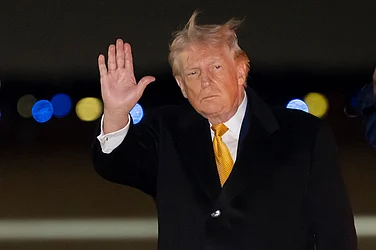The unexpectedly fierce, determined and creative resistance put up by Ukraine in the face of Russia’s full-scale invasion is the result of the combined efforts of a mobilised civil society, the government and the country’s armed forces. Aerorozvidka, which means aerial reconnaissance, a nongovernment organisation founded by information technology (IT) experts and drone enthusiasts in 2014, embodies the role of civil society in the conflict. This was demonstrated by small teams of special mobile forces, armed with Aerorozvidka’s home-made drones that succeeded in halting the 40-mile-long armoured convoy of the Russian Army headed towards Kyiv in the first month of the invasion, which began in February this year.
This was key to saving Ukraine’s capital. Yet Aerorozvidka, whose website describes it “as a non-profit organisation that promotes creating and implementing net-centric and robotic military capabilities for the Ukrainian security and defence forces”, sources technology and parts largely through volunteer networks and crowdfunding. “Aerorozvidka exemplifies the direct engagement of civil society in repelling aggression against Ukraine,” it adds.
At an Aerorozvidka event we attended in the centre of Kyiv in late July, a film about their founding father ‘Chewbacca’ was screened in a grand auditorium. The event was also attended by an unlikely assembly of IT geeks and soldiers. During the show, air-raid sirens began to blare across the city, but the screening continued uninterrupted. At one point, the soldiers were asked to stand up to robust applause. This is the unlikely mix of civilian IT professionals and soldiers that makes Aerorozvidka so effective.
As one of the presenters at the event put it, Aerorozvidka is “not just an organisation, but a way of life”. In other words, a community that straddles the civilian–military divide to great effect. After the film show, Aerorozvidka’s head of IT explained, “This is a war fought through information.” He was not talking about social media and public opinion—although drone footage has been vitally important there as well—but pointing out that in an artillery duel, the side with the most accurate and timely reconnaissance wins. This is how Ukraine’s much smaller force has managed to hold its own against far superior numbers: better information utilised more effectively.
Starlink satellite internet, a new technology provided by Elon Musk’s SpaceX in response to a Twitter plea from Ukraine’s minister of digital transformation, enabled the continuous connectivity required. Russia, with advanced drones and electronic warfare capabilities, was widely expected to dominate the sky. Ukraine’s drone operators—innovatively supported by civil society—managed to flip the script.
Euromaidan to Russian war
We sat down at a café in a leafy waterfront neighbourhood of Kyiv for a discussion with Vadym, a large, affable man nicknamed the ‘Father of Drones’. “I am the head of the drones and robotics department of Aerorozvidka NGO,” he says. “At first, we bought drones, but they were expensive, and companies were reluctant to modify some of them for military use. So, we started to make drones ourselves.”
Vadym’s journey began when, after a series of jobs, including a stint as a Pentecostal preacher, he began working as a photographer. Like thousands of Ukrainians, Vadym was swept up in the country’s 2013–14 Euromaidan protests that many describe as the ‘revolution of dignity’. The protests, which demanded closer ties between Ukraine and Europe, culminated in then president Viktor Yanukovych fleeing to Moscow, followed by Russia’s annexation of Crimea and the beginning of war in eastern Ukraine. Vadym first used his drone as a Euromaidan activist.
“I bought my first drone for photography 10 years ago. That led me to Aerorozvidka. In 2013, I made my own drone, purchasing parts and assembling them,” he says. “When the revolution started, I joined Aerorozvidka as a volunteer. We used this drone to see what the police were doing on the other side of the square. On February 19, 2014, it crashed at Independence Square, the area in Kyiv where Euromaidan protests were taking place.” He adds, “I was given the nickname ‘Father of Drones’. But I think it would be more appropriate to call me ‘Mother of Drones’, because I worry about everything.”
Vadym’s family speaks Russian like millions of other Ukrainians. It is the dominant language in Donbas and Crimea—regions claimed by Russia. While the country’s 1996 Constitution prohibits a bilingual system, it also guarantees that Russian will be developed as a minority language.
When Vadym was 17 in 1991, the Soviet Union collapsed and Ukraine became independent. “Many crimes of the Soviet Union were uncovered and censorship on books was lifted,” he says. “The first book I read after the collapse of the Soviet Union was A History of Ukraine by Mykhailo Hrushevsky. It made a deep impression on me. Thanks to this book, I understood who I am. All Ukrainians share a common trait—we are ready to say ‘No, it won’t be like that’ to something we don’t like.”

This is a sentiment that has become increasingly widespread since the invasion began. I ask if he expected the war. Unlike most Ukrainians I interviewed, for whom it was completely unexpected, Vadym had been involved in defence efforts since 2014 and had come to see Russia as a colonial oppressor. “It is simple: if you have land and people come to you with a tractor, put up a fence on your land, bring building material. For 350 years, Russia interfered and tried to destroy us.”
He then launches into an extended history lesson on Russia’s suppression of Ukrainian culture and identity, concluding, “They always wanted us to forget about the existence of Ukraine and who we are.”
As Vadym’s personal trajectory reveals, Aerorozvidka emerged from the Euromadian protest movement, was part of volunteer defence efforts in 2014 and then was absorbed into the Armed Forces of Ukraine, becoming what one report termed “probably the most innovative unit in the Ukrainian Army”. But this innovation came into conflict with entrenched interests within Ukraine’s post-Soviet military.
The war ahead
Vadym continues, “We were part of the armed forces because we wanted to introduce drones into the Ukrainian Army. But in 2019, this part was disbanded because of the corrupt actions of three generals, still serving. So we are no longer a part of the armed forces. But not much has changed for us because Aerorozvidka is not just an NGO, it is a phenomenon. People gathered here share the same principles, the same goals and are ready to work for it.”
Aerorozvidka has traversed a dizzying trajectory from being a group of volunteer activists to an elite unit of the armed forces to an NGO with an expansive network. Consider its unique structure that Vadym refers to as a phenomenon. It only has around 100 official members, but when I asked how many people are involved, no one could give me a number, saying there are too many to count.
People affiliated to Aerorozvidka are spread across the armed forces and many of their IT specialists work at the Innovation Centre under the Ministry of Defence. Much of their work is done through informal channels. As Vadym puts it, “When there is no need for an official request and everything can be simplified by asking friends, then we do so.” This is the power of what Ukrainians call horizontal networks that bypass formal institutions weakened by excessive bureaucracy, corruption and decades of Russian influence.
What ties their diverse efforts together is the Delta situational awareness system. Vadym explains, “This is a layering system. Each unit has its own level where they collect information. Not everyone can see all the information; it depends on their position. But when all the layers are superimposed, [senior commanders] can see the whole situation, all the data on one screen.” In other words, Delta integrates information from diverse sources.
An Aerorozvidka post describes how in its situational centres, “Information flows there from various sources: stationary cameras, sensors, drone streams, intelligence from the field and data from allies. In the centres, information is analysed, processed and uploaded to the digital cloud. The situational centre is a technological hub that unites and coordinates technical means of intelligence and helps to conduct joint operations of the defence forces effectively.” Ukraine’s defence effort is decentralised, involving not only the armed forces of Ukraine but also newly constituted territorial defence forces, civilian administrators and a growing network of what Ukrainians’ call partisans operating behind enemy lines. Therefore, a platform to integrate and coordinate these diverse actors is required if Ukraine is to succeed in the daunting task of reclaiming land conquered by a vast and dug-in Russian army.
But Vadym is optimistic. He points out, “The Delta system is already a big reform. The system itself reduces the risk of information leakage and the paths of corruption schemes.” He believes that since the invasion began, reform is occurring much faster. “Our achievement: an order has already been issued that the armed forces should use the Delta system. In my opinion, we have not yet reached the peak of the war; it is stil l ahead. Therefore, we need the support of foreign partners and the reform of our army,” he says.
Aerorozvidka provides a window into how the armed forces of Ukraine are undergoing a process of reform even as it mobilises all means to fight off the world’s second-largest army. It may well be the case that the side with the most effective reforms will ultimately prevail, especially in the long run.
(This appeared in the print edition as "Fighting a Formidable Foe Together")
(Kateryna Lupan contributed to this story in Kyiv.)

























